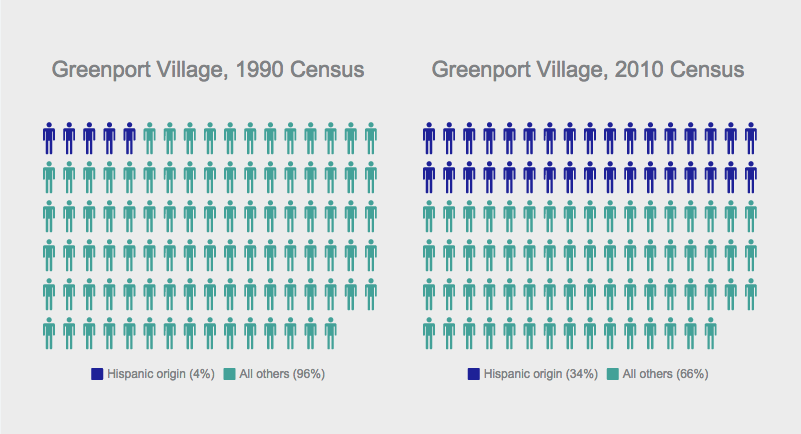Has the Hispanic immigration boom ‘saved’ Greenport?


On the third page of the preface to her book exploring the wave of Hispanic immigration to Greenport over the past two decades, Diana Gordon quotes former mayor David Kapell in a four-word aphorism: “They’ve saved this town.”
That statement is essentially the thesis Ms. Gordon develops in the 200-plus pages that follow.
Her book, “Village of Immigrants: Latinos in an Emerging America,” is both a series of portraits and an analysis of Greenport as a hub for immigrants who have made the journey, either with or without documentation. It intertwines scholarly exploration of issues — one chapter discusses how local schools have handled a greater number of students who struggle with English, another considers the local health care infrastructure — with personal accounts of the journeys and struggles that Latino Greenporters face.
Ms. Gordon will discuss her book and sign copies at 3 p.m. Saturday at Floyd Memorial Library.
Regardless of their status, Ms. Gordon argues, Hispanic immigrants have helped Greenport recover from decades of stagnation. They form the backbone of its labor-dependent tourist economy, they patronize local businesses all year, and they have reinvigorated the village’s history as a bastion of diversity.
“In terms of providing the labor, the underpinnings of this new economy, [immigrants] have been absolutely crucial,” Ms. Gordon said. “And that’s been happening in many places.”

Ms. Gordon, a retired professor of political science and criminal justice at the City University of New York, has been a full-time Greenport resident herself since 2008. Her work was inspired partly by a simple observation around that time that there seemed to be more and more Hispanic residents in the village.
Greenport does have almost four centuries of history as a beacon for migration, thanks in part to its maritime character. Its most famous local restaurant, Claudio’s, proudly proclaims its Portuguese history, and its Tall Ships Festivals have welcomed sailors from around the world.
But the influx of Hispanic residents has been rapid and substantial. The 1990 federal census counted 83 people of Hispanic origin in Greenport Village, about 4 percent of its total population. By the 2010 census, that number had risen to 746 people, or 34 percent of village residents.
Mr. Kapell, who served as mayor from 1994 to 2007, said Greenport was uniquely poised in the 1990s, with enough labor and available housing, to attract such an explosion.
“It was a supply-and-demand trend,” he said. “[Greenport] was a place where people could find work, it was a place where people could find housing and it was a place where people could walk to work.”
Because Greenport was accessible to them in those ways, Mr. Kapell believes immigrants reinvigorated the village and saved it from becoming a near vacuum in terms of diversity, with a culture dominated by old-time natives and wealthy transplants.
“Somebody had to move in, and if it wasn’t going to be the Latino population — which we need for our labor force — it was going to be second-home owners,” he said. “[Immigrants] sustain our tradition as a real working-class town.”
Those federal census numbers might even underrepresent the size of Greenport’s Hispanic community. In November 2006, motivated by a Christmas Eve Mass at St. Agnes Church attended by “500 or 600” Latino residents, Mr. Kapell commissioned his own census, which counted about 1,300 more residents — including more than 350 Hispanics — than had been documented by the 2000 federal census.
With such a dramatic rise in immigration, much of which occurs illegally without visas or permits, Greenport’s various institutions have had to adjust. Ms. Gordon sees plenty of success in the village, however.
Greenport’s accomplishments were a key motivator for Ms. Gordon’s work, because she sees the village as an exemplar for small towns across America.

In such places, she said, young Americans no longer interested in farm or factory jobs have packed up and moved to cities, leaving opportunities for immigrants. And by taking those jobs, Ms. Gordon found, Hispanic immigrants prevent further decay and decline, keeping the population from excessive aging and allowing local businesses to stay open and fruitful.
“I wanted to use this as an illustration of the development that, I began to learn, was happening in many parts of the country,” she said. “Small-town America has been in decline since shortly after World War II, and what has happened in states like Iowa is that small towns are now supported in part by immigrants.”
Education and health care are two areas in which Greenport earns Ms. Gordon’s praise. In the schools, she said, teachers and administrators have adjusted well to the growing number of Hispanic students. During the 2011-12 academic year, Latinos constituted more than half the students in the district’s elementary school, Ms. Gordon wrote.
“These are the future voters and workers and volunteers in Greenport, these children,” she said. “That’s going to change Greenport even more in the next generation.”
In her book, Ms. Gordon cites several examples of how the school district adapted: Letters are sent home in Spanish when needed, assemblies embrace a wider variety of cultures and teachers are making greater efforts to learn Spanish or improve language assistance for those who are not native English speakers.
David Gamberg, who took over last year as superintendent of Greenport’s schools, said some students come to the United States years after dropping out of school in their home countries, which poses unique challenges for educators.
“If the student is 15 or 16 years old and is in a high school Regents class and hasn’t been in school since elementary school, you can imagine what that challenge would look like,” Mr. Gamberg said. “You want the student to get more used to the basics of school, not just the challenges of a Regents-level class in high school.”
Ms. Gordon also identified Greenport as uniquely successful in navigating the complex task of providing Hispanic residents — many of whom are barred from receiving Medicaid and other subsidies because of their immigration status — with suitable health care.
Services for immigrants in the area, she wrote, “are generally of high quality for both routine complaints and critical health problems.” Such quality is in large part thanks to the Greenport Health Center, a clinic whose head doctor, Blaise Napolitano, is quoted in the book as saying, “We don’t turn anyone away.”
For all its progress, however, Ms. Gordon and Mr. Kapell would like to see Greenport Village government make greater strides to integrate the immigrant population.
During his tenure, Mr. Kapell appointed Gustavo Acero, a native of Colombia, to the Planning Board. But such a gesture has not been made since, and Ms. Gordon said no immigrants currently sit on any village committees.
The Hispanic community in Greenport faces a variety of other obstacles. Half the chapters in Ms. Gordon’s book follow the journeys of immigrants, describing their challenges with sympathy and honesty. One chronicles a barber who wants to open his own business but cannot without a Social Security number. Another tells the story of a single mother who could not travel to Mexico to tend to a dying grandparent because she would have to leave her children behind and might not be permitted to return.
“Something I very much want to do with this book is to give voice to some of the immigrants,” Ms. Gordon said.
While labor exists in large quantities, there is little upward mobility, according to Sister Margaret Smyth of the North Fork Spanish Apostolate.
“The jobs go from entry-level type to highly professional, and it’s hard to get that in-between,” she said.
And while Greenport has a history of tolerance, Ms. Gordon feels there is not enough blending between native-born citizens and its newer residents.
Some locals bristle at the idea of sharing their community with a growing Hispanic population — which Ms. Gordon considers NIMBY-ism, an acronym for “not in my backyard” — and that tension creates further obstacles for immigrants.
“I think at the local level, you have to take the position that you have no control over the border,” Mr. Kapell said. “For whatever reason, by default, benign neglect or outright conspiracy, the federal government allowed this migration to take place … But they’re our neighbors. The kids are being born here. You have to find a way to accommodate them. It’s the right thing to do.”
Photo: Hispanic worshippers prepare to run from Greenport to Riverhead in 2013 to deliver a holy flame honoring Our Lady of Guadalupe, a popular religious symbol. (Credit: Paul Squire, file)








